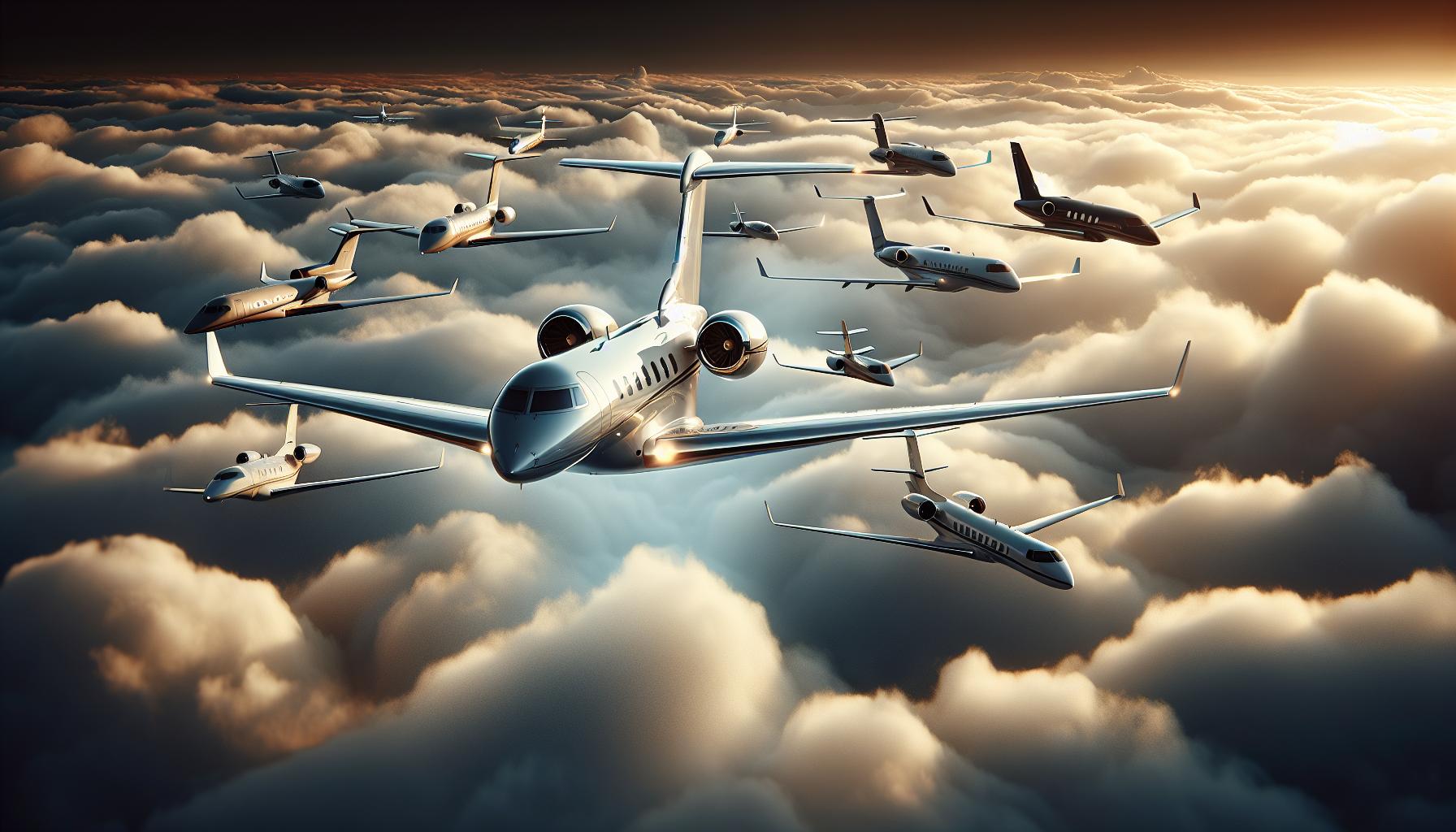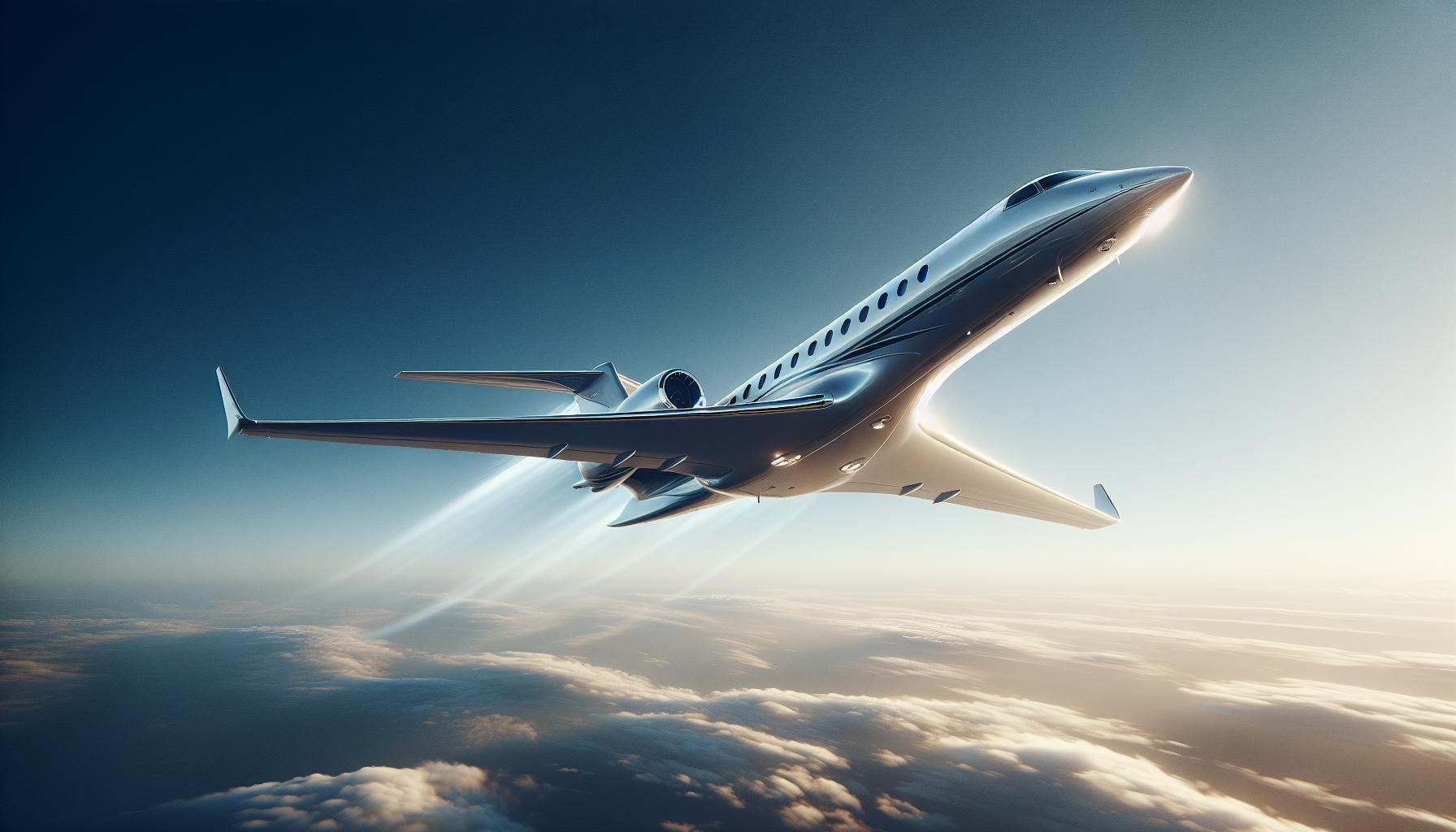
Ever wondered what it’s like to soar through the skies with the luxury and speed of a private jet? I’ve spent years in the private jet business, and I’m here to give you the insider scoop on what a 3-hour flight might cost you.
The allure of private flying is undeniable, but the price tag can be a mystery. Stick with me as I break down the costs, from fuel to crew, and share my insights on getting the best bang for your buck in the clouds.
Whether you’re planning a high-powered business trip or a lavish getaway, understanding the expenses involved is key. Let’s dive into the world of private jets and discover just how much that three-hour flight could set you back.
Understanding Private Jets
Before we dive into the hourly costs, let’s get acquainted with what private jets entail. When you hear “private jet,” it’s easy to picture glitz and glamour, but there’s more beneath the surface. Private jets vary by size, range, and amenities. Light jets are perfect for shorter trips for a small group, while heavy jets can accommodate more passengers and offer longer ranges.
I’ve flown on different types of jets and can say that each experience is unique. A light jet, like a Citation Mustang, is sleek and efficient for quick jaunts. On the other hand, a Gulfstream can make a three-hour flight feel like a voyage in a luxury hotel.
The type of jet impacts the cost significantly. Let’s break it down:
- Small or Light Jets: Ideal for 6–8 passengers with a range of about 1,500 miles.
- Midsize Jets: Great for 7–9 passengers and distances up to 3,000 miles.
- Large or Heavy Jets: Designed for 10+ passengers and can fly nonstop over 4,000 miles.
Operating a private jet goes beyond the aircraft type. Costs include fuel, maintenance, crew salaries, airport fees, and insurance. Fuel is a big chunk, but don’t overlook regular maintenance and crew training that ensure safety and performance reliability.
Each trip’s cost depends on many variables. For instance, if my flight departs from a major hub, fees might be higher due to demand. However, opting for a secondary airport could reduce the cost. And while it’s tempting to go big on amenities, remember they might add a premium to your flight.
Knowing these factors helps me make informed decisions. I don’t just look at the sticker price; I consider the entire picture. It’s not just about how much you pay, but what you get for your money. And that’s something I always keep in mind whether I’m flying for business or leisure.
Factors Affecting the Cost of a Private Jet

When considering the cost of a private jet for a 3-hour flight, several key factors come into play. It’s not just about the aircraft type; every aspect of the journey can influence the overall cost. Let’s break it down.
Flight Duration and Distance
Obviously, the longer the flight, the more fuel you’ll need, and with fluctuating fuel prices, this can have a serious impact on cost. Distance affects not only fuel but also required crew time and potential overnight fees if the crew needs to stay somewhere before the return flight.
Aircraft Type and Size
From light jets to large-cabin luxury aircraft, each has a different operational cost. A smaller jet is generally less expensive to operate than a larger one. Here’s a quick rundown:
- Light Jets: Ideal for shorter trips, usually seating up to 8 passengers.
- Midsize Jets: A balance between comfort and cost, accommodating around 10 people.
- Heavy Jets: Offer more space, amenities, and longer range, suitable for up to 16 passengers.
Crew Expenses
Crew salaries and training are already factored into the cost. But when they’re away from their home base, you’ll cover their lodging and meals, which adds to your bill.
Airport Fees
Landing fees, ramp fees, and other charges vary considerably from one airport to another. Busier airports often charge more, while smaller, regional airports could be a way to cut costs.
Maintenance and Insurance
Regular maintenance ensures safety and performance but doesn’t come cheap. Insurance premiums for flying machines are substantial, and yes, you’ve guessed it – that affects the price too.
In-Flight Services
If you’re looking for a catered experience with high-quality meals, Wi-Fi, and other amenities, prepare to pay extra. These perks might seem small but can accumulate quickly.
Planning a trip with a private jet is a complex task. Each of these factors can swing the cost significantly. Smart planning and a clear understanding of what’s essential for your trip will help manage expenses. But remember, the luxury and convenience of private flying often justify the investment.
Fuel Costs for a 3-hour Flight

Fuel expenditure is a major component when calculating the costs of a private jet journey. The price of fuel can fluctuate based on several factors, with oil prices on the international market being the most significant variable. For a 3-hour flight, the type of aircraft will greatly influence how much fuel is needed.
Let’s break down the fuel consumption. Light jets, commonly used for short to medium distances, will consume less fuel compared to heavier, larger jets designed for long-haul flights. For instance, a light jet like the Hawker 400XP might burn around 200 gallons per hour. In contrast, a larger jet such as the Gulfstream G550 can easily consume over 400 gallons per hour.
Fuel prices are subject to change and can vary drastically from one region to another. At the time of writing, the average cost of jet fuel hovers around $5.50 per gallon. However, it’s important to stay updated as these rates can shift. To illustrate how this impacts overall costs, let’s make a quick calculation:
| Aircraft Type | Fuel Burn Rate (Gallons Per Hour) | Hourly Fuel Cost (USD) |
|---|---|---|
| Light Jet | 200 | 1,100 |
| Large Jet | 400 | 2,200 |
Given these numbers, for a 3-hour trip, a light jet would roughly lead to a fuel cost around $3,300, while a large jet would double that expense to $6,600.
To effectively manage the fuel budget, I’ll always recommend checking for the most efficient routes and considering potential fuel stops, particularly for international flights where refueling might be cheaper. It’s also smart to monitor fuel surcharges that can be added to the basic charter fee. These are billed to cover the volatile nature of fuel prices and can significantly impact the end cost of your flight.
Always keep in mind that the estimated costs are a starting point. Unpredicted headwinds or route changes can increase fuel consumption, consequently increasing the expenditure. Efficient planning and constant price monitoring are integral to making sure you’re not caught off-guard by your private jet’s fuel costs.
Crew and Staff Expenses

When booking a private jet, I’ve learned that crew and staff expenses can form a substantial portion of the overall cost. These expenses encompass the salaries and per diem of pilots, co-pilots, and if necessary, flight attendants. Every professional on board plays a crucial role in ensuring a safe and enjoyable experience, so there’s no cutting corners here.
Pilot costs can vary, depending on their experience and the complexity of the flight. Typically, a seasoned pilot demands a higher rate, and in the world of private jets, you’re paying for the best. A co-pilot is almost always required for these flights, and naturally, adds to the cost. Flight attendants, while not mandatory on all private jets, are often included for their invaluable service, particularly on luxury flights where guest experience is paramount.
Here’s a breakdown of average crew costs for a 3-hour private jet flight:
| Crew Member | Average Cost |
|---|---|
| Pilot | $500 |
| Co-pilot | $300 |
| Flight Attendant | $200 |
Remember that these figures can fluctuate based on regional wages and supply and demand. Additionally, there may be costs associated with positioning the crew if they’re not based at the departure airport, which includes their travel and accommodation expenses.
For international flights, crew expenses can escalate due to extended layovers, overnight stays, and other logistical necessities. Having a clear contract that outlines all crew-related costs upfront can prevent any surprises in the bill.
It’s savvy to consider these expenses when planning your journey. By understanding the details behind crew and staff expenses, I can better anticipate the total cost of hiring a private jet and manage my budget more effectively. With meticulous planning and a keen eye on each component, like crew costs, I’m able to make informed decisions that ensure a top-notch flying experience without unnecessary spendings.
Other Operating Costs

Aside from crew and staff expenses, there are other operating costs to consider when flying by private jet. Hangarage and ground services are significant factors. Let’s break them down.
Hangarage isn’t just a place to store the jet; it’s also about protection from the elements and security. Depending on the location and the duration of the storage, prices can fluctuate. When it’s not soaring through the skies, your jet needs a safe spot, and hangar fees can add up pretty quickly, especially in premium locations.
Ground services are equally important; they include ground transportation, catering, and cleaning services. These aren’t fixed costs and can differ greatly based on the level of service you’re after. Everyone loves a spotless cabin and a great meal up in the air, but they come at a price.
Then there’s insurance. Just like with cars, the bigger and more expensive the jet, the higher your insurance premiums. This cost scales with risk factors, previous flight history and, of course, the level of coverage you opt for. I’ve learned it’s best to shop around and find a plan that balances cost with protection.
Lastly, there’s the topic of depreciation. It’s often overlooked but bears mentioning. Even though it’s not a direct out-of-pocket expense per flight, the value of a jet diminishes over time and with use. Savvy travelers factor this in when budgeting for their air travel since it informs long-term expenses.
When you add these costs to your budget, you’ll start to get a realistic picture of the expense of operating a private jet for a 3-hour flight. It’s not just about the flight itself; it’s the care and keeping of the aircraft before and after, too. Remember to include these details when planning your journey to avoid any surprises when it comes to finances.
Choosing the Right Aircraft

When you’re looking at the costs for a private jet for a 3-hour flight, selecting the right aircraft is crucial. There’s no one-size-fits-all answer here; it’s about finding the balance between comfort, range, and cost.
Light jets are often the go-to for short-haul flights. They’re more economical than their larger counterparts and perfect for groups of up to 8 people. With sleek designs and impressive efficiency, they’re ideal for personal or small business trips. Here’s a quick rundown:
- Cessna Citation Mustang: A popular choice known for low operating costs.
- Embraer Phenom 100: Offers a stylish interior and swift performance.
Moving up, midsize jets provide extra space and amenities. Think of them like the business class of the skies — a bit more legroom, the ability to stand up, and usually a small galley. They can handle cross-country flights effortlessly, making them a smart pick for those willing to invest a little more for comfort. Models like the Hawker 800XP stand out with their blend of performance and luxury.
Super-midsize jets bridge the gap between midsize and large cabin jets. They offer transcontinental range and higher speeds. Aircraft such as the Challenger 300 come into play here, providing ample space without breaking the bank.
Lastly, heavy jets are synonymous with the pinnacle of private flying. While more costly, they deliver an unmatched experience. They’re outfitted with full galleys, luxurious seating arrangements, and even bedrooms on some models. If you’re looking to splurge, the Gulfstream G450 is a testament to opulence and comfort.
Remember, the right aircraft for your 3-hour flight will depend on your specific needs. Are you prioritizing cost, comfort, or perhaps both? Factor in the number of passengers and your desired level of luxury before making a decision. Each jet category has its own merits, so weigh your options carefully, and ensure you’re choosing wisely to make your journey not just a trip, but an experience.
Tips for Getting the Best Deal

When it comes to snagging the best deal for a 3-hour private jet flight, I’ve learned a few strategies over the years that can save you a hefty sum.
Be Flexible With Your Schedule
Flight prices can vary greatly depending on the time of day and week. Mid-week flights often cost less than weekend jaunts, and flying during off-peak hours can also slash the price. If you’re not tied to specific times, let the charter company know you’re looking for the best rate. They’re usually more than happy to help you find a more wallet-friendly option.
Book in Advance—or Last Minute
Strange as it may seem, booking way ahead or snagging a last-minute deal can both be cost-effective. Early birds often get the worm with discounts for advance bookings. Meanwhile, last-minute flyers can take advantage of empty leg flights, which occur when a jet needs to return to its home base or reposition for the next customer. These can offer significant discounts, but they’re less predictable and require you to be spontaneous.
Consider a Jet Card or Membership Program
If you’re thinking about flying private regularly, jet cards and membership programs can be a boon. They usually come with a prepaid number of flying hours at reduced rates. Think of it as a bulk discount for frequent flyers.
Stay Informed and Network
Staying on top of the market is key. Follow charter companies on social media, subscribe to their newsletters, and don’t be shy to ask for a deal. Networking with other private fliers can also lead to opportunities for joint charters, sharing the cost while still enjoying the luxury.
Compare Different Aircraft
Recall that an appropriate jet type can make a world of difference in cost. When I’m planning my flights, I always compare different aircraft because sometimes a light jet will suffice when I thought I needed something heftier. This can translate into savings, especially for shorter, 3-hour flights where the extra space and amenities might not be as necessary.
Conclusion
Frequently Asked Questions
How can I get the best deal on a 3-hour private jet flight?
To secure the best deal, be flexible with your schedule, consider booking either in advance or last minute, and explore jet card or membership program options. Stay informed about market rates and network within the industry.
Is it better to book a private jet in advance or last minute?
Both strategies can yield savings. Booking in advance provides early-bird discounts, while last-minute bookings can offer reduced rates for unsold inventory. Assess your needs and monitor offers to determine the best approach.
What is a jet card or membership program?
A jet card or membership program is a pre-paid option that offers access to private jet flights at fixed hourly rates. It often comes with added benefits like guaranteed availability and consistent service.
Why is networking important when booking private jets?
Networking within the aviation community can provide insider knowledge on special deals, discounts, and availability. Building relationships with operators and brokers can lead to more competitive pricing and personalized service.
How does the choice of aircraft affect the cost of a private jet flight?
The type of jet impacts the cost significantly. Lighter jets are generally more economical for shorter flights like a 3-hour trip, as they consume less fuel and incur lower operational costs than larger jets.
